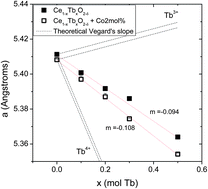Bulk ionic and electronic transport properties and the rate of oxygen surface exchange of Tb-doped ceria have been evaluated as a function of Tb concentration, aiming to assess the potential use of the materials as high-temperature oxygen-transport membranes and oxygen reduction catalysts. The materials were synthesized by the co-precipitation method. Cobalt oxide (2 mol%) was added in order to improve sinterability and conductivity. The materials were studied by means of X-ray diffraction (XRD), temperature-programmed desorption (TPD), thermogravimetry (TG), DC-conductivity and UV-vis spectrophotometry. The results indicate that the extent of mixed ionic–electronic conductivity is a function of temperature and can be tuned by modifying the Tb- (and Co-doping) concentration. Low Tb-content materials (x = 0.1 and 0.2) are predominant ionic conductors, but the materials with 50 mol% Tb show both p-type electronic and ionic conductivity. The enhanced electronic conduction in Ce0.5Tb0.5O2−δ is associated with narrowing of the band gap upon doping ceria with Tb. In addition, the surface chemistry of the samples was investigated by means of X-ray photoelectron spectroscopy (XPS) and pulse isotopic exchange (PIE). The surface exchange rate is found to increase on increasing the level of Tb doping. The highest surface exchange rates in this study are found for materials doped with 50 mol% Tb.

You have access to this article
 Please wait while we load your content...
Something went wrong. Try again?
Please wait while we load your content...
Something went wrong. Try again?


 Please wait while we load your content...
Please wait while we load your content...